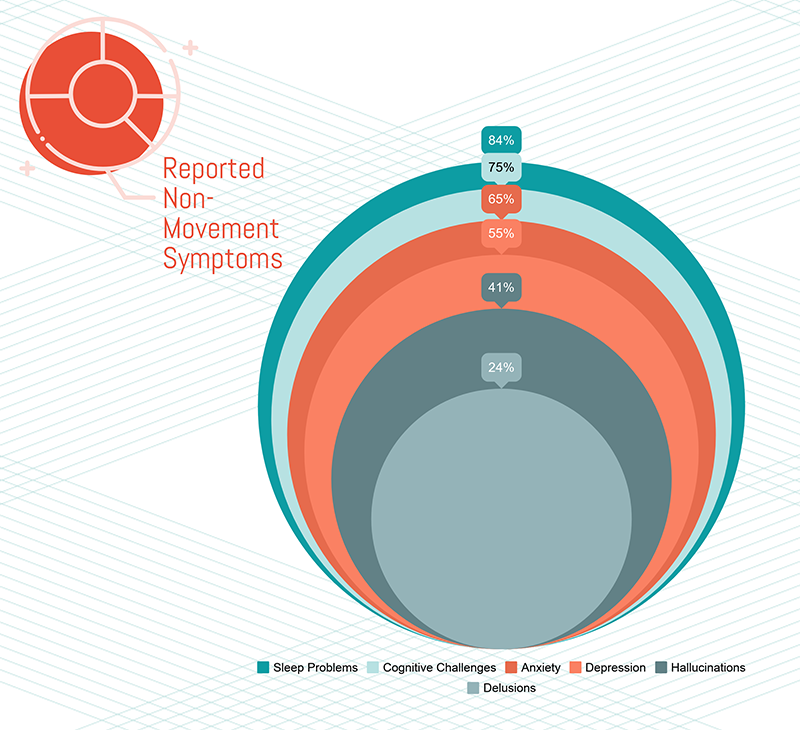An online survey of 650 people who either have Parkinson’s disease or care for Parkinson’s patients revealed how non-movement symptoms for those with Parkinson’s disease (PD) can often be misread and inconvenient for daily life.
The survey, sponsored by Parkinson & Movement Disorder Alliance (PMD Alliance) and ACADIA Pharmaceuticals Inc., found that of the participants, 90 percent reported they or their loved one with PD experienced non-movement symptoms, such as sleep problems, cognitive challenges, anxiety, depression, hallucinations and delusions.

Percentage of individuals who experience non-movement symptoms from survey
Those who experienced non-movement symptoms mostly associated these symptoms as having a negative effect on their quality of life. Challenges associated with non-movement symptoms included the inability to sleep, unable to plan for future events, struggle with socialization, battling with household chores and errands and more.
“It is profoundly unsettling for people as they find themselves struggling to make plans with friends and family, run errands or even plan for future…these are activities that many of us do regularly and take for granted…” said Sarah Jones, MPA, MS, CEO of Parkinson & Movement Disorder Alliance (PMD). “These are the hidden challenges of the disease. It is why this disease is so remarkably misunderstood.”
More frequently, non-movement symptoms and cognitive challenges are more often recognized by care partners rather than the person experiencing Parkinson’s disease. Oftentimes, a person with PD does not report symptoms such as delusions and hallucinations to health care providers, possibly from embarrassment or the patient does not know it is a side effect associated with PD.
Although, non-movement symptoms are harder to see compared to physical symptoms such as tremors, stiffness and slowness, PMD Alliance was surprised that such a large number of the respondents experienced or noticed non-movement symptoms in their loved ones with PD.
In light of these findings, PMD Alliance said non-motor symptoms appear years, even decades, before motor symptoms appear and the individual is diagnosed with PD. By the time the patient is diagnosed, almost 60-80 percent of their dopamine has been lost.
“If we can raise awareness about these symptoms, people may be able to visit a movement disorder neurologist more quickly, and begin a care plan earlier,” Jones said.
In order to help PD individuals feel more in control of their life, PMD Alliance created emPowered! a tool for tracking symptoms and reporting them to a doctor. This tool requires people with PD to enter information into booklets about medications, daily activities and symptoms. The patient then brings these booklets to their appointment to help guide the conversation with their doctor.
“We are fiercely dedicated to providing not simply education, but helping people translate education and information into practical tools for everyday living,” said Jones. “This disease can leave people feeling powerless. We believe information with actionable tools is the definition of power.”
Although it is imperative people with Parkinson’s disease continue to educate themselves, it is just as vital that care partners continue to inform health providers of different PD indicators. Interestingly, more care partners completed the online survey than people with PD. This may be because care partners see how their loved one is progressing each day with the disease.
“We know that this disease is experienced by everyone in the circle, and often times the care partners and adult children will see symptoms long before a person with PD might,” said Jones. “Listening to care partners is an essential part of care.”
Because no two people with Parkinson’s have the same symptoms, it is considered one of the more complex movement disorders since there is no standard path or established collection of symptoms. Therefore, awareness and education is essential to motivate friends and family to talk about Parkinson’s disease. PMD Alliance has urged the Parkinson’s community to initiate conversation and continue to educate one another.
“We are grateful to have these voices in sharing the true impact of this disease,” said Jones. “Talking about these issues will be the only way to reduce isolation and fear.”




